| Silverton Magazine - Silverton, Colorado | ||
| Downtown Silverton | Burke's Custom Tours for Photographers & Artists | Silverton Magazine Home Page |
|
Walking Tour - Historic Downtown Silverton |
|
All content © San Juan Publishing Group, Inc, All rights reserved.
If you would like a hardcopy of this mailed to you, please send a self-addressed stamped envelope to us (address at bottom of page.) Historical descriptions excerpted from the print version of Silverton Magazine 2000-2010, and the historical tour authored by the late Allen Nossaman. Text has bee edited and updated periodically by Silverton Magazine Editors. Duotones, James Burke. ALL material herein is copyright San Juan Publishing Group, Inc. and may not be reproduced by any means whatsoever. To do so, will invite immediate legal action. For the complete historical walking tour, order a copy of the print version of Silverton Magazine from San Juan Publishing Group, Inc., PO Box 705, Ridgway CO 81432. (Email: [email protected]) West side of Greene Courthouse Square 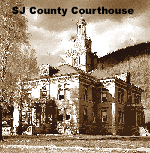 Historic Museum/County Jail/Mining Heritage Museum. Originally the San Juan County Jail, this was erected in 1902, five years before the neighboring Courthouse. It was designed with the sheriff’s living quarters on the first floor. Little use was made of the jail after a couple of decades, and during the 1930s, the building housed indigents. Vacant for more than twenty-five years after that, it is now open to the public during the summer as the museum of the San Juan County Historical Society. Behind it, a world-class mining museum in the reconstructed Caledonia Boarding House.
Historic Museum/County Jail/Mining Heritage Museum. Originally the San Juan County Jail, this was erected in 1902, five years before the neighboring Courthouse. It was designed with the sheriff’s living quarters on the first floor. Little use was made of the jail after a couple of decades, and during the 1930s, the building housed indigents. Vacant for more than twenty-five years after that, it is now open to the public during the summer as the museum of the San Juan County Historical Society. Behind it, a world-class mining museum in the reconstructed Caledonia Boarding House. San Juan County Courthouse. With its ornate gold-colored dome and clock tower, the San Juan County Courthouse is one of the most beautiful in the state. Built in 1907 at a cost of $79,000, the structure did not require issuance of bonds or an increase in taxes to construct. It is newly renovated and still fully in use. 14th & Greene 126 W. 14th. The original structure on this site was built in 1883. C.A. Cooper opened an assay office in it during 1897. He constructed this new front office in 1903 to spruce up the assay lab in the rear, which has since been razed. The building was later home to Root & Norton, Assayers until 1919. 1421 Greene. (Kendall Mtn. Cafe) The Hoffman Rooming House occupied the entire corner lot at the turn of the last century. 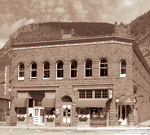 1371 Greene. (Wyman Hotel) The Wyman Building, constructed of native red sandstone, was completed in 1902 by pioneer packer Louis Wyman. He hand carved the burro on the building’s nameplate above the corner as a tribute to the stubborn but indispensible creatures. The structure was home to the Silverton Commercial Club, Hemphill & McCrimmons Dry Goods and various lodges and professional men before housing a trucking firm, filling station and parking garage prior to its recent restoration as a hotel. 1371 Greene. (Wyman Hotel) The Wyman Building, constructed of native red sandstone, was completed in 1902 by pioneer packer Louis Wyman. He hand carved the burro on the building’s nameplate above the corner as a tribute to the stubborn but indispensible creatures. The structure was home to the Silverton Commercial Club, Hemphill & McCrimmons Dry Goods and various lodges and professional men before housing a trucking firm, filling station and parking garage prior to its recent restoration as a hotel.
1345 Greene. (burned and boarded) This brick structure was erected by John Walters in 1907 and is typical of the construction which took place during the apex of Silverton’s building boom in the first decade of the 1900s. It first housed Fulton’s Market, and was the longtime home of The Economy Store, a clothing and dry goods outlet. It was adapted as a recreational center named The Eight Ball in the 1970s, when the town’s only bowling alley was moved into the basement. On February 24, 1993, the building was damaged when the heavy snow load left by a storm caused the roof to collapse. The building was gutted by fire in 2001. 1335 Greene. (Weathertop Wovens) This frame structure, built no later than 1876 by Frenchman Frank Chabrand as a saloon, is one of the oldest in Silverton. After one year, it became the shop of Silverton’s first butchers, John Scrivner and John and Charles Pearson. In 1881, it was acquired for a drug store by David L. Mechling, who left Silverton but returned in 1910 as the driver of the first automobile to enter the county. The building was adapted to use as a laundromat in the 1960s. The doorway to the right of the laundry was a separate, tiny storefront between 1881 and 1907, and among other businesses, housed a boot and shoe shop, a Chinese laundry, a jewelry store and a barber shop. 1333 Greene. (Silverton Brewery) As early as 1895, this building served as Silverton’s Post Office. In the 1920s, it was a Post Office in the back and in front, a drug store and mercantile run by Charles Cooper. In the 1940s, Frank Salfisberg took over the Post Office, moving it up front. Art Lorenzen moved the drug store to the brick building on the corner (where Hold Your Horses is today) and named it the Post Office Drug Store. 1327/1325 Greene. (Adelaide’s Antiques) The northern twin of these identical buildings was finished in 1901, eclipsing its neighbor by a couple of months. Fritz Hoffman graduated from secondhand goods to a first-class hardware store with this building’s completion and proudly had his name in stone over the cornice. Surveyor R.W. Hollis was the first professional tenant upstairs, which was also the location of the office of attorney William A. Way, who practiced law in Silverton for more than sixty years. The commercial space was a hardware store until 1982. 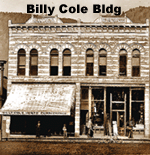 1323 Greene. (POW Restaurant/bar) The name of Billy Cole adorned the cornice cap of this 1901 structure in just the same style as his friend Hoffman next door. Cole was in gentlemen’s furnishings and had opened his line in a frame building on this site, which had earlier housed the Gem Saloon and The Arlington, the latter counting Wyatt Earp among its card dealers in 1883. The retail space has also been home to dry goods outlets, grocery stores and offices. The upstairs was originally an alcohol-free billiard parlor operated by Jack Cole, Billy’s son. It was later made into apartments.
1323 Greene. (POW Restaurant/bar) The name of Billy Cole adorned the cornice cap of this 1901 structure in just the same style as his friend Hoffman next door. Cole was in gentlemen’s furnishings and had opened his line in a frame building on this site, which had earlier housed the Gem Saloon and The Arlington, the latter counting Wyatt Earp among its card dealers in 1883. The retail space has also been home to dry goods outlets, grocery stores and offices. The upstairs was originally an alcohol-free billiard parlor operated by Jack Cole, Billy’s son. It was later made into apartments.
1309 Greene. This structure, which originally bore a nameplate for builder, W.C. Rogers, was erected in 1909 as a saloon. Prohibition prompted its conversion into the Star Theater in 1916, and it subsequently became the Gem Theater in 1925, and Lode Theater in 1938. The last motion picture theater screening in Silverton took place in this building in January 1990. 1303 Greene. (Mountains Calling) Constructed in 1895 by pioneer Silverton merchant George Bausman, this brick structure opened as Bausman’s General Merchandise. Attorney J.T. Whitelaw and Dr. E.L. Ingersoll were among the first professional men upstairs. The store became Sam Wittow’s Clothing Store and later the Post Office Drug Store, first in a series of community drug stores in the location until 1982. 13th & Greene 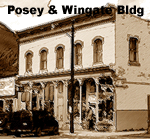 1269 Greene. (Storyteller / Handlebars) The Posey & Wingate Building was built in 1880, and is probably the oldest commercial brick building in western Colorado. Its builders went into the hardware business, but the retail outlets on both frontages have also housed clothing stores and beer halls. The corner section was home to the First National Bank of Silverton from 1883 to 1934, when the bank closed and fully paid all depositors. It had only two cashiers during its entire existence. The bank vault is still in place. The corner housed a recreation hall for nearly thirty years after the bank closed. The second story was devoted to a wide variety of mining company and legal offices and to the earliest telephone exchange.
1269 Greene. (Storyteller / Handlebars) The Posey & Wingate Building was built in 1880, and is probably the oldest commercial brick building in western Colorado. Its builders went into the hardware business, but the retail outlets on both frontages have also housed clothing stores and beer halls. The corner section was home to the First National Bank of Silverton from 1883 to 1934, when the bank closed and fully paid all depositors. It had only two cashiers during its entire existence. The bank vault is still in place. The corner housed a recreation hall for nearly thirty years after the bank closed. The second story was devoted to a wide variety of mining company and legal offices and to the earliest telephone exchange.
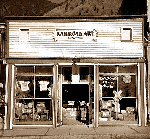 1257 Greene. (Train Store) This frame structure put up in 1875 by George Wright, a former merchant at Howardsville, is one of the oldest business buildings in Silverton. It housed the general store of Joe Lacome in 1876, and its longest occupants were Hemphill & McCrimmon Dry Goods. Former occupant, The Silverton Standard and The Miner is the oldest continuous newspaper business in western Colorado.
1257 Greene. (Train Store) This frame structure put up in 1875 by George Wright, a former merchant at Howardsville, is one of the oldest business buildings in Silverton. It housed the general store of Joe Lacome in 1876, and its longest occupants were Hemphill & McCrimmon Dry Goods. Former occupant, The Silverton Standard and The Miner is the oldest continuous newspaper business in western Colorado.
1249 Greene. (Funnel Cakes and Enameling Shop) George Wright also erected this building in 1875, and occupied it as the Alhambra Saloon for a short time. The structure has been divided into two fronts most of its existence and has housed everything from barbershops to shoe repair shops to assay offices. 1245 Greene. (Silverton Minerals and Gifts) New building built when snow caved in roof of former building on this site. 1237 Greene. (Rocky Mountain Gifts) This ornate frame structure dates from May 1884, when it was completed as the St. Julien Restaurant. Its French owner was remodeling a modest one-story building on the site when snow from an adjoining roof demolished his building. He decided to produce a much grander structure, aided by a healthy court settlement. The edifice housed a saloon most of its years, and the upper rooms were quarters at various times for the Western Federation of Miners and numerous professional offices. *1231 Greene. (Fetch’s) Built by town father Thomas Blair in 1883 after moving a small Chinese laundry off the lot. The frame building has housed a saloon most of its life, the earliest proprietors being Dave Lowenstein and Johnny May. The second story was Silverton’s Odd Fellows Hall from 1884 to 1893. During the last century, a series of proprietors operated The Club here, with imbibing on the ground floor and various echelons of gambling in both the basement and the second floor. 1227 Greene. (Indian Plaza) A frame building on this site, literally in the shadow of the massive Grand Hotel, was replaced with the current masonry structure in 1903 by butcher Bert Brown, who thought he would occupy the building but transferred it instead to Cunningham & Crocker, a longtime leading drug and jewelry firm. This partnership maintained a freestanding ornate sidewalk clock on the premises for many years. Druggists or jewelers occupied the building for more than fifty years, up through the closing of the Blue Cross Drug Store in the 1950s.  1219 Greene. (Grand Imperial Hotel / Gumbys Bar and Dining Room / Ortega’s Old Town Indian Store) Started in 1882 and finished in 1883 as the Thomson Block, this landmark structure built by W.S. Thomson of England became the Grand Hotel shortly after its completion, and has remained a hotel through the years, later as the Imperial Hotel and finally as the Grand Imperial. Its main floor has housed a variety of businesses, from saloons to clothing stores to newspaper offices, and the second floor was once used as the courthouse. The Hub Saloon is a longtime first-floor fixture in what has at times been referred to as the Showplace of the Silver Kings.
1219 Greene. (Grand Imperial Hotel / Gumbys Bar and Dining Room / Ortega’s Old Town Indian Store) Started in 1882 and finished in 1883 as the Thomson Block, this landmark structure built by W.S. Thomson of England became the Grand Hotel shortly after its completion, and has remained a hotel through the years, later as the Imperial Hotel and finally as the Grand Imperial. Its main floor has housed a variety of businesses, from saloons to clothing stores to newspaper offices, and the second floor was once used as the courthouse. The Hub Saloon is a longtime first-floor fixture in what has at times been referred to as the Showplace of the Silver Kings.
1171-1191 Greene. (vacant lot) Heavy snows in the winter of 2007/08 collapsed the roof and the building imploded. The former building here was long owned by the Savich family. The corner was rented to Tony Giacomelli who ran a family bar and cafe. The building also housed a liquor store run by Mary Mattivi and a bakery run by the Bonaventura family. 1157 Greene (vacant) Formerly one of Silverton’s first gift shops and lapidary, run by Wiley Carmack who now owns Outdoor World. For years, the building was owned by Lou Purcell, owner of the Circle Route Garage. He rented the building to Johnnie Forman, who for thirty years ran the San Juan Grocery and Meat Market. The building also once housed the Purcell’s Silverton Light Company. 1151 Greene. (vacant) Prior to WWII, Art Thick and another barber ran the Silverton Barbershop here, and post-WWII, the Silverton Veterans of Foreign War Post moved in and established a club. 1139-1145 Greene. (vacant/My Favorite Things) New buildings constructed in 1997. 1129 Greene. (Brown Bear Cafe) Pioneer butcher Fred Humbolt erected this building in 1893. It was the longtime home of the Silverton Meat and Produce Co., which involved partnerships among Fred and Adolph Humbolt and Charles and John Pearson, the first butchers in the county. Upstairs quarters housed the Odd Fellows Lodge and the Woodmen of the World. The latter purchased the building in 1919. The Foresters Lodge and the Miners Union also met upstairs at various times. The ground floor became a saloon with its purchase in 1933 by Phil Sartore, and it was subsequently known as the Pastime and then as the San Juan Bar and Melodrama Theater. 1119 Greene. (vacant) In 1910, the Silverton Standard newspaper print shop. 1121 Greene. (San Juan Backcountry) This frame building was built in 1883 and occupied by Horace Greeley Prosser and his wife, Laura, who combined a furniture dealership and an undertaking parlor. They were in business here until 1901, when they moved to the Miners Union Building across the side street to the south. The building then housed various clothing retailers and a gymnasium. 11th & Greene 1069 Greene. (American Legion / Miner’s Tavern ) The Western Federation of Miners finally finished the Miners Union Hall in 1901 after beginning in 1900 and trying to avoid high bricklaying prices by doing the work themselves. The imposing building at once became home to a wide variety of labor organizations in the community, and many lodges here as well. The second floor contained a large dance floor. The Prossers moved their furniture and undertaking business here in 1901, and two other morticians followed through the years. Upon the decline of the unions, the building was purchased by the American Legion, and now houses that group’s meeting rooms downstairs, as well as the Miners Tavern. The second floor is leased by A Theatre Group. East side of Greene 1124 Greene.* (Cow Palace, closed temporarily) Still known as “the drive in” which it was for many years. 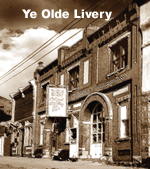 1142 Greene. (Ye Olde Livery & Kurrowong Gallery) Billed as the fanciest livery stable in Colorado’s mountains when it was erected in 1897, this building was the home of the Silverton Transfer Co. It was put up by Clint A. Bowman, who ultimately left San Juan County to found what was to become the Bowman’s Biscuit Company. His onetime partner John Melton operated the livery thereafter, and still later, J.B. Patterson was the owner. It featured an elevator to reach its second level. The facility declined after the advent of the horseless carriage.
1142 Greene. (Ye Olde Livery & Kurrowong Gallery) Billed as the fanciest livery stable in Colorado’s mountains when it was erected in 1897, this building was the home of the Silverton Transfer Co. It was put up by Clint A. Bowman, who ultimately left San Juan County to found what was to become the Bowman’s Biscuit Company. His onetime partner John Melton operated the livery thereafter, and still later, J.B. Patterson was the owner. It featured an elevator to reach its second level. The facility declined after the advent of the horseless carriage.
1150 Greene. (Henry Smith’s Gifts) This was a part of the old Circle Route Garage complex established in 1913 when the “Circle Route” highway to Durango was being built. The garage operated into the 1950s. Greene & 12th. (K&C Mountain Traders) The original building on this lot housed the Circle Route Stage Stop. When automobiles displaced stage coaches, Lou Purcell established the Circle Route Garage, with gas pumps on the corner. Later, the building housed a mining museum and gift shop run by Zeke Zanoni, until the roof collapsed during a terrible storm in the mid-1970s. The building has housed its current businesses for many years. 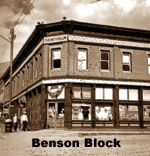 1200 Greene. (Citizen’s State Bank) Most commonly known through the years as the Benson Block, this structure was constructed in 1901 by pioneer, barkeep and miner Knut Benson from profits he made on two mines at Ophir: the Butterfly and the Terrible. Harold Kid Whitelaw opened the San Juan Country Club on the corner (part of the name is still on the top cornice) with the most expensive bar fixtures ever imported to Silverton, but within a year, Benson was dead and Whitelaw was out of business. The premises became the Hotel Melton, and later the Hotel Kendall, and housed a series of saloons. It also housed the Vienna Cafe until 1921, was the home of one of the town’s first automotive garages where the bank is now, and is legendary for its complex floor plan.
1200 Greene. (Citizen’s State Bank) Most commonly known through the years as the Benson Block, this structure was constructed in 1901 by pioneer, barkeep and miner Knut Benson from profits he made on two mines at Ophir: the Butterfly and the Terrible. Harold Kid Whitelaw opened the San Juan Country Club on the corner (part of the name is still on the top cornice) with the most expensive bar fixtures ever imported to Silverton, but within a year, Benson was dead and Whitelaw was out of business. The premises became the Hotel Melton, and later the Hotel Kendall, and housed a series of saloons. It also housed the Vienna Cafe until 1921, was the home of one of the town’s first automotive garages where the bank is now, and is legendary for its complex floor plan.
1200-1218 Greene. All are part of the old Benson Hotel, and have housed a number of enterprises including a gift shop, restaurant, saloon, beer hall and beauty salon. The ground floor of the building is currently vacant. 1228 Greene. (Indian Trading Post) Built in 1896 by photographer and saloon owner John V. Lorenzen and his partner, Joe Grivetto, this picturesque building was the Chicago Saloon, a port in the storm for countless Italian immigrant miners through the years. It was thought more respectable than Blair Street taverns, but still made its own liquor during the days of Prohibition, as did a majority of Silverton saloons. *1234 Greene. (Outdoor World & Alpine House) Commissioned in 1972 by Wiley Carmack, this is one of the newest buildings on Greene Street and has always housed his outdoor clothing and equipment business. 1248 Greene. (Exchange Livery / Great Divide Company) Originally a two-story brick and stone structure, the Exchange Livery was constructed by the Doud brothers in 1906. It sheltered buggies and wagons downstairs and horses upstairs. Miners needing a ride to their claim would rent a horse for $2, ride to the locations, and turn the horse loose. The animal would walk back to town and up the ramp to its stall in the livery. The top story caved in from snow load in later years. 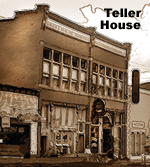 1250 Greene. Teller House Hotel, upstairs/(San Juan Grill & San Juan Trading, downstairs) This double-front brick structure was erected in 1896 by successful local brewer Charles Fischer, and its lodging facility soon was christened the Teller House in honor of mining-conscious Sen. Henry Teller. The first-floor frontages originally housed a series of saloons including onetime neighbors The Frog for the French and The Tyrol for the Italians. In 1916, the building was purchased and converted into the last home of The French Bakery, a grocery and bakery concern, which existed as a grocery until the 1970s.
1250 Greene. Teller House Hotel, upstairs/(San Juan Grill & San Juan Trading, downstairs) This double-front brick structure was erected in 1896 by successful local brewer Charles Fischer, and its lodging facility soon was christened the Teller House in honor of mining-conscious Sen. Henry Teller. The first-floor frontages originally housed a series of saloons including onetime neighbors The Frog for the French and The Tyrol for the Italians. In 1916, the building was purchased and converted into the last home of The French Bakery, a grocery and bakery concern, which existed as a grocery until the 1970s.
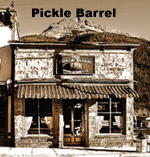 1304 Greene. (Pickle Barrel / Smedley’s Ice Cream) One of the oldest masonry buildings in Silverton, this structure was erected in 1880 as the general store of Sherwin & Houghton by stone masons imported from Del Norte. It served as retail space for a number of other early-day concerns, including M. Breen & Co., and the Nathan Shoe and Clothing Co. Chiono & Giacomelli converted the place to their Iron Mountain Saloon in 1900, but Prohibition turned the business into an ice cream parlor. It was empty for many years until its conversion into a restaurant.
1304 Greene. (Pickle Barrel / Smedley’s Ice Cream) One of the oldest masonry buildings in Silverton, this structure was erected in 1880 as the general store of Sherwin & Houghton by stone masons imported from Del Norte. It served as retail space for a number of other early-day concerns, including M. Breen & Co., and the Nathan Shoe and Clothing Co. Chiono & Giacomelli converted the place to their Iron Mountain Saloon in 1900, but Prohibition turned the business into an ice cream parlor. It was empty for many years until its conversion into a restaurant.
1320 Greene. (Orange Crate) The open area in front served as an outside storage area for the Carl D. Curtis lumberyard, which was across the street (in a now vacant building). The building that is now the Orange Crate was used to store cement, plumbing supplies and materials that couldn’t be out in the open. 1330 Greene. (vacant) This two-story wooden building has housed various enterprises including an insurance office and clothing store. 1338 Greene. This modest two-story brick building was put up in 1901 as an office building by Whitelaw & Whitelaw, attorneys who had originally come from Dodge City. The building ultimately housed Silverton’s telephone exchange, one of the very last in Colorado to be converted to dial. 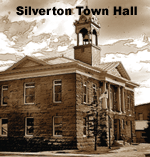 1360 Greene. (Town Hall) Started in 1908, the seat of Silverton’s municipal government was finished in 1909, but not before a colonnade of four pillars fell off the front and the project changed contractors. It was built at a cost of $14,500 of the same native stone as the Wyman Building across the street and underwent restoration in 1976 with assistance of a grant from the National Park Service. On November 30, 1992 a fire gutted the building. Work to restore the building to its original state was completed in 1996. The restoration won several awards, including the National Preservation Honor Award. 1360 Greene. (Town Hall) Started in 1908, the seat of Silverton’s municipal government was finished in 1909, but not before a colonnade of four pillars fell off the front and the project changed contractors. It was built at a cost of $14,500 of the same native stone as the Wyman Building across the street and underwent restoration in 1976 with assistance of a grant from the National Park Service. On November 30, 1992 a fire gutted the building. Work to restore the building to its original state was completed in 1996. The restoration won several awards, including the National Preservation Honor Award.
Reese Street 1271 Reese. Masonic Lodge No. 33, AF & AM was chartered in 1878 and met in two locations since razed on Greene Street before purchasing this building in 1893. The Lodge has met here ever since. The striking building was built in 1883 for the plant of the “San Juan Herald” downstairs and the pretentious Silverton Club for men upstairs. The “La Plata Miner” moved into the printing quarters in 1885. The building initially occupied only the front half of the lots but was extended to the alley in 1902 with the completion of a beautiful Lodge room on the second floor and apartments beneath. Public School. The present school building, which houses grades K-12, was built in 1911. Its immediate predecessor was an elaborate two-story Victorian frame structure just south of the present building. The first school built by the community as such was a one-story frame which stood just south of that at the opposite end of the block. 1111 Reese (Carnegie Library) Silverton’s Public Library was erected in 1906 as a Carnegie-funded institution, at a cost of $12,000. The interior furnishings of the library are largely original, and the lower level, originally designed as a men’s reading and club room, has been restored by the library’s board. The facility was the crowning accomplishment of a drive to provide library services. It replaced a series of free reading rooms which had been scattered throughout the community since the 1880s. 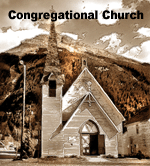 1060 Reese. Silverton’s Congregational Church was established in 1876 and formally organized on November 24, 1878. The cornerstone of the church building was laid August 20, 1880, making it the oldest Congregational Church structure still hosting services in the state, now meeting as the United Church of Silverton. The first call to worship was achieved by pounding on a saw blade. A detached bell stand was built in 1881, and the bell tower and steeple replaced it in 1892. The adjoining parsonage was built in 1884. 1060 Reese. Silverton’s Congregational Church was established in 1876 and formally organized on November 24, 1878. The cornerstone of the church building was laid August 20, 1880, making it the oldest Congregational Church structure still hosting services in the state, now meeting as the United Church of Silverton. The first call to worship was achieved by pounding on a saw blade. A detached bell stand was built in 1881, and the bell tower and steeple replaced it in 1892. The adjoining parsonage was built in 1884.
1005 Reese. St. Patrick’s Catholic Church has been in this brick edifice since its completion in 1905. The building took two years to erect from the groundbreaking in 1903, but much of the work was accomplished by volunteer labor among Italian miners also versed in masonry work. The entire project was paid off three years from its initiation. The rectory next door was built in 1906. The first Catholic church had been built a block up the hillside and had been moved once to the site of the current rectory. Snowden Street 1045 Snowden. (Wingate House Bed & Breakfast) Contracted by Silverton’s “Russian Princess,” Emma Harris, this gracious Queen Anne-style manor was built in 1889 by Harris’s good friend F.O. Sherwood, and purchased in 1890 by Mayor J.W. Wingate. At the time, this neighborhood was Silverton’s “Nob Hill.” The Salazar family raised a large brood of children here in the 1950s and 1960s. Famed local renovating duo Fritz Klinke and Loren Lew restored the house to its current grandeur and sold it to Judith Graham who now runs a bed-and-breakfast here. 1105 Snowden. The third of Silverton’s historic church structures, this house of worship was put up as St. John’s Episcopal Church in 1898, but a shortage of funds found the church board renting it to the school for overflow classroom space until it could be furnished and opened as a church in 1901. This building was the site of funeral services for toll road and railroad builder Otto Mears. After the decline of the Episcopalian congregation, the church was subsequently a Foursquare Gospel Church and a Southern Baptist Church. The belfry was originally part of the schoolhouse at the now abandoned town of Eureka.  1315 Snowden. (Old County Hospital) Francis M. Snowden built one of the first cabins in Silverton here in 1874. The present structure was built as a hospital by the Miners Union in 1907, and all the men in the organization donated a shift or two from the mines to work on the building. It became the property of San Juan County in 1939 and continued as a hospital until the mid-1950s, after which it was leased as mining company offices, and that of the Colorado Avalanche Information Center.
1315 Snowden. (Old County Hospital) Francis M. Snowden built one of the first cabins in Silverton here in 1874. The present structure was built as a hospital by the Miners Union in 1907, and all the men in the organization donated a shift or two from the mines to work on the building. It became the property of San Juan County in 1939 and continued as a hospital until the mid-1950s, after which it was leased as mining company offices, and that of the Colorado Avalanche Information Center.
Side Streets 124 E. 13th. (presently an exercise studio) Constructed as a bottling works by Peter Orella in the summer of 1907, this replaced a livery stable on the site. Both beer and carbonated beverages were bottled here, and some embossed and etched bottles survive from Orella’s enterprise. The cellar and the elevator in this building were among the finest in town. Empty for years, the building was reopened as a Baptist Church before acquisition by the present owner in 1969. *Public Restroom at Ourdoor World and Fetch's. Also at Triangle Service, at the "Y," the Visitor Center, and the Information stand on Blair Street. Photographs Top: Animas Forks, 11,300 ft., highest mining town in San Juan County. ©Kathryn Retzler Center: City Hall and historic buildings, Greene Street. ©Kathryn Retzler Bottom: Silverton Depot and Engine 480 pulling the Durango & Silverton Narrow Gauge train into town. ©James Burke |
|
The Silverton Magazine. Copyright 2000-2010 Published by San Juan Publishing Group, Inc., Colorado No part of this publication may be reproduced in any means whatsoever without written authorization from SJPG. (plagerizers will be hung from the yardarm and fed to the mountain sharks!) Queries for re-print rights, email [email protected] |
Copyright San Juan Publishing Group, Inc. Web design by Kathryn R Burke